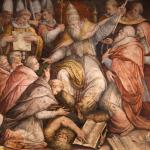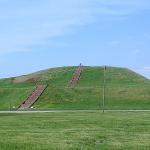In a paper on Academia.edu, Alan Darley of the University of Nottingham examines Thomas’s revision of the Pseudo-Dionysian notion of hierarchy, stressing the importance of Scripture in Thomas’s revisionary efforts.
Along the way, following a number of recent scholars, he highlights the central role of Scripture in the Summa. He admits that “a superficial reading of the Summa Theologiae had given some the impression that Thomas used Scripture mainly in a proof-texting fashion as only one amongst a number of auctoritates.” This impression is partly due to the late publication and inadequate distribution of Thomas’s biblical works. Darley insists, though that for Thomas the Scriptures function as “the auctoritate auctoritatibus as the supreme criteria for judging between competing authorities.”
Scripture is not only authoritative but, according to Thomas, perspicacious. Darley cites Milbank’s observation that Thomas sometimes sounds Protestant when writing of the clarity of Scripture. This is the “point of divergence between Dionysus and Aquinas.” They agree on the authority and divine origin of Scripture but they differ in hermeneutical method. For the former, Scripture is “intentionally ‘mystic,’ i.e., ‘concealed’”: in Dionysus’ words, “To avoid harm it granted only as much light as suited the weak eyes looking up to it.” Origen undermined the implied elitism of this assumption, and Thomas diluted it still more. This democratization of Scripture is based on his faith in the accessibility of the Bible. If God had given only philosophical knowledge of Himself, then “the truth about God such as reason could discover would be known by a few, and that after a long time, and with the admixture of many errors. . . . Therefore, in order that the salvation of men might be brought about more fitly and more surely, it was necessary that they be taught divine truths by divine revelation.”
The other great divergence from Dionysus is in Thomas’s stress, following the Victorine theologians, on the historical sense of Scripture. For Dionysus, the “bare historical domain” is a jumping-off point for “the sacred journey to the heart of sacred symbols.” For Thomas, the literal sense is the root from which all spiritual senses flower. As Darley points out, the literal sense is the “normative” sense in Thomas’s theology. Thomas revises the Dionysian notion of hierarchy by an application of the quadriga, founded on the historical sense.
This leads Darley to this conclusion: “Aquinas shares much with Pseudo-Dionysius in regard to the Divine inspiration, authority, and canon of scripture. The main development in Aquinas is his reconfiguring of Augustine’s four senses of scripture to accommodate Denys’ analogical approach within a wider Victorine framework which acknowledges the literal sense with its locus in history and authorial intention as the normative one for doctrine and the pedagogical foundation for the higher spiritual senses.” In this way, Thomas “transforms the surface meaning of the Pseudo-Dionysian texts” and “effectively ‘baptises’ him as a faithful Catholic.”















